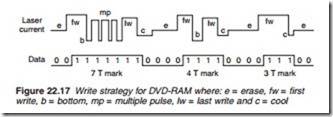Burst cutting area
The burst cutting area is invariably used to stamp up to 188 Bytes of infor- mation related to the individual disc such as ID codes and serial number or any other information that may be used for inventory purposes or stor- age systems such as jukeboxes for quick identification of the individual disc. It may be read by the same pickup head that is used for reading the user data off the disc.
Recordable and re-recordable discs have the same burst cutting area organisation as DVD ROMs. Where they differ is in the layout of the infor- mation or data zone as illustrated in Figure 22.16.
Write strategies
Laser current waveforms needed to record on different media (CD-R, CD- RW, DVD±R, DVD±RW, DVD-RAM, HD-DVD, Blu-ray) vary, depending on the media and on the data transfer rate used. The shape and timing of these laser current waveforms for these different media and different data transfer rates are referred to as ‘write strategy’. A write pulse generator (WPG) is used to feed the appropriate current into the laser driver to pro- duce the required laser current waveform. An example of a laser current waveform for a typical DVD-RAM write strategy is shown in Figure 22.17.
When a logic one follows a logic zero, the laser current is increased to the “first write” (fw) level. If the number of consecutive ones is only three (3 T mark from right to left in Figure 22.17), the shortest allowed mark length for DVD-RAM, the laser current pulse consists only of the “first write” and the “cool” (c) levels, before going back to the erase level. For a 4 T mark, the laser current pulse is already a little bit more complex: A “bottom” (b) and a “last write” (lw) pulse are inserted between the “first
write” and the “cool” level. For marks longer than 4 T, as shown for 7 T, multi-pulses (mp) are inserted between the “first write” and the “last write”. Typical HD-DVD strategies are very similar to the DVD-RAM strategy shown in Figure 22.17, but the number of multi-pulses is higher by 1, e.g. a 7 T mark has 4 instead of 3 multi-pulses and the shortest allowed mark length is 2 T.
While the laser current can have up to six levels (erase, first write, bot- tom, multi-pulse, last write, cool), the differential output current of the WPG is only a four-level signal. Some relatively simple mapping from the four current levels of the WPG output signal to the six levels of the laser current needs to be done by the laser driver IC. Having only a four-level signal rather than a six-level signal increases robustness of the data trans- mission. The main task of the WPG is to generate the precise timing for the laser driver.
Other strategies used for standards other than DVD-RAM use simpli- fied variants of the patterns shown in Figure 22.17. Such as the “bottom” level made equal to the “erase” level and dispensing with the “cool” pulse and so on.
